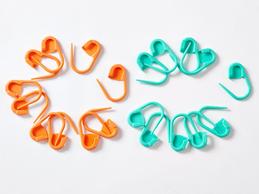Beginner's Guide to Knitting Materials List
If you are new to knitting you may not be familiar with all of the knitting accessories that are available to make your knitting life easier and more productive! Let the tools do the thinking so you can focus on knitting!!
The beginner's essentials... just starting out
At a minimum to start knitting, you'll need yarn and needles!
Medium weight yarn
Encore or Cascade 220 worsted or chunky weight yarn. 1 skein, NOT black! (or overly variegated). 1 skein is about 100g, 200 yards. You can make a gauge swatch and a hat in my beginner's course!
|
Knitting Needles
US size 8 or 9 straight or circular needles. If you are planning on knitting a flat hat (free pattern here!) then get straight needles. Otherwise, if you are planning on learning how to knit in the round, get a set of circular 16" US size 8 or 9 needles and a set of 5 double pointed needles US size 8 or 9 (approx 7 inches in length). I highly recommend buying bamboo or driftwood needles as opposed to metal, since they are less slippery and that's better for new knitters.
|
And if you want to get just a few more things that will ease your mind as you learn and continue to knit...

A yarn needle is a pretty essential tool for all knitters. You'll usually need this to weave in your ends, but it comes in handy on almost every project.
|

Measuring gauge becomes more and more important as you continue to knit things that require fit - i.e. sweaters and hats. With scarves you can often get away without measuring gauge. But anything that you want to match the size of a pattern, will require knitting a gauge. (See here for how to knit a gauge!). Additionally, once you start to acquire more and more knitting needles, you might need this ruler to determine what size all of those needles you own are!
|
More advanced tools...

If you are venturing into the world of cable knitting (woohoo!), then the cable needle is your essential tool. There are a couple of varieties. A straighter version, with a small bump in the middle, or the type that is more of a hook. Try both and see which you prefer! The rule of thumb is that you will slip stitches onto the short end of the needle, and then knit off the longer end. You can also use a spare double-pointed needle to hold your cable stitches!

Stitch holders are a very necessary tool for many projects. Generally these come into play on sweater knitting, when you are keeping some stitches "live", while you continue to knit another section of the garment.








